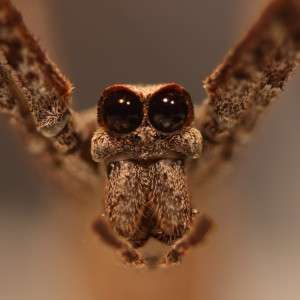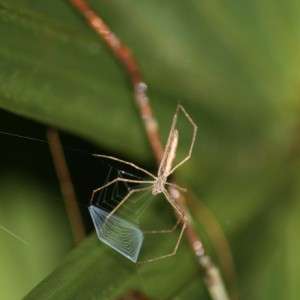May 18, 2016 report
Testing proves giant eyes of net-casting spider help with nocturnal foraging

(Phys.org)—A pair of researchers has tested the theory that the enormous eyes sported by net-casting spiders are to help the spider capture walking prey at night. In their paper published in the journal Biology Letters, Jay Stafstrom and Eileen Hebets, both with the University of Nebraska, describe field and lab experiments they carried out that showed the purpose of the oversized eyes.
Many visitors to Florida have been alarmed by the sight of a small spider with humongous eyes—the net casting spider, so named because of the unusual shape of the webs it creates—fortunately, the spiders are harmless to humans. Interestingly, until now, no one has gone to the trouble of actual testing the spiders to fully understand why they have such big eyes—the largest proportionally, for any arachnid.
To prove the theory that the big eyes evolved to help with night foraging, the researchers started by video-taping several of them as they went about their activities in their natural environment. Then, they captured some samples and applied dental silicone over the single pair of big eyes (net-casters, like other spiders have eight eyes altogether, the others eyes are much smaller) temporarily blinding those eyes. The research pair then recorded the activities of the spiders as they tried to survive without benefit of their huge eyes.
In studying the results, the researchers found that the blinded spiders were much weaker hunters when their big eyes were covered. Removing the eye covers allowed the spiders to regain their former skill levels.
In a second test, the researchers conducted a similar experiment, except they did it in a controlled environment in their lab. In studying the results, the researchers found almost identical results.

The research pair suggest their study shows that net-casting spiders use their huge eyes to hunt walking prey at night; they allow for catching prey in near dark conditions—prey which is very often much larger than they would catch with their net only. They noted also that the partially blinded spiders were just as adept at dealing with prey that was caught in the web, which adds more credence to the idea that the evolution of the large eyes, was strictly to allow the spider to catch larger prey while hunting during the nighttime—which the researchers also note, is a much safer time to hunt as there are far fewer predators out looking to eat them.
More information: Nocturnal foraging enhanced by enlarged secondary eyes in a net-casting spider, Biology Letters, rsbl.royalsocietypublishing.or … .1098/rsbl.2016.0152
Abstract
Animals that possess extreme sensory structures are predicted to have a related extreme behavioural function. This study focuses on one such extreme sensory structure—the posterior median eyes of the net-casting spider Deinopis spinosa. Although past research has implicated the importance of vision in the nocturnal foraging habits of Deinopis, no direct link between vision in the enlarged eyes and nocturnal foraging has yet been made. To directly test the hypothesis that the enlarged posterior median eyes facilitate visually based nocturnal prey capture, we conducted repeated-measures, visual occlusion trials in both natural and laboratory settings. Our results indicate that D. spinosa relies heavily on visual cues detected by the posterior median eyes to capture cursorial prey items. We suggest that the enlarged posterior median eyes benefit D. spinosa not only through increased diet breadth, but also by allowing spiders to remain active solely at night, thus evading predation by diurnal animals.
Journal information: Biology Letters
© 2016 Phys.org




















